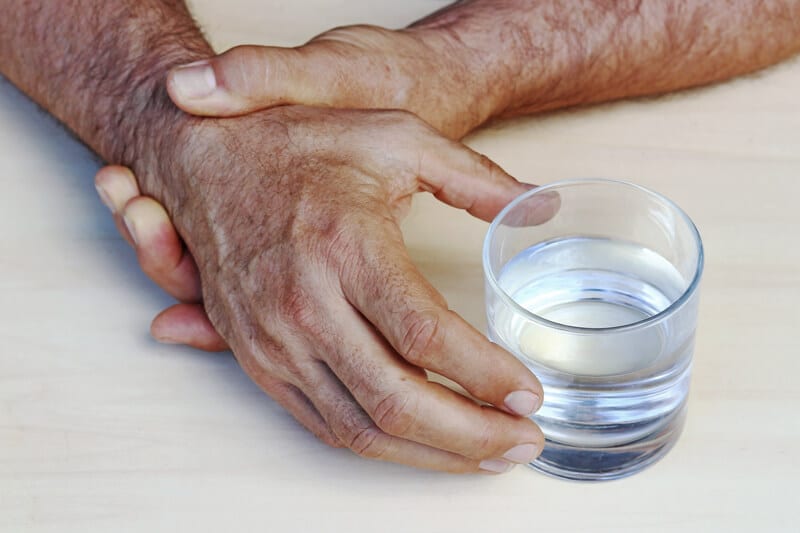Patients with a neuromuscular disease such as Parkinson’s disease (PD) are at increased risk of aspiration pneumonia, malnutrition and reduced quality of life. The underlying reason for these risks is respiratory muscle weakness, which can negatively impact three different but connected, physiological processes:
- Speech
- Swallow
- Cough
Respiratory muscle training (RMT) successfully improves respiratory muscle weakness, alleviating associated symptoms by treating the underlying cause [1].
SPEECH
More than 90% of PD patients have hypokinetic dysarthria, which may also be one of the first visible symptoms at disease onset. It manifests with problems in articulation, phonation, speech rhythm and fluency, as well as speech associated facial expressions. As these symptoms are typically not associated with dopamine deficits, medication such as dopaminergic replacement therapy does not improve them [2].
Speech production relies on muscle activation that greatly overlaps with that of breathing, including diaphragm and chest wall, to coordinate the larynx, glottis and vocal folds with the upper and lower airway systems. Activation of both inspiratory and expiratory muscles together provide the best control of chest wall function and optimal speech support.
Evidence: A preliminary study showed that RMT improves respiratory muscle strength and lung volume initiation during speech in PD patients, thereby improving speech breathing and intensity [3].
SWALLOW
Swallow impairments are common in PD patients and greatly contribute to malnutrition, reduced QOL, social isolation, and aspiration pneumonia, the leading cause of death in PD. More than 80% of PD patients develop dysphagia during the course of their disease. Some forms of dysphagia can be partially treated by pharmacological interventions; mainstay therapy however is swallowing treatment by SLTs, including respiratory muscle training [4]. Coordination between breathing and swallowing needs to be highly coordinated to prevent aspiration. The preserved pattern of swallowing at the right lung volume to prevent aspiration is often disturbed in PD patients, and swallowing may occur during inhalation rather than exhalation.
Strengthening the respiratory system supports swallow function by improving laryngeal function to ensure airway protection, prevent aspiration, and reduce pneumonia risk; by increasing ribcage flexibility to improve lung volume and ease of inhalation before swallow; and by improving cough function to strengthen the cough reflex for good pulmonary hygiene, airway clearance and to prevent aspiration. In addition, respiratory muscle training can lay the foundation for conscious re-training of a correct breathe-swallow pattern.
Evidence: RMT improves swallow safety by decreasing compression phase duration and increasing hyolaryngeal movement, thereby lowering the risk of aspiration [5,6].
COUGH
Voluntary cough is an important airway protection mechanism to prevent aspiration pneumonia and is often impaired in PD patients. Clearance of small airways to prevent aspiration during swallowing is based on sequential voluntary cough. Initiation and pattern of sequential voluntary cough are often impaired in PD patients, especially in the presence of dysphagia, suggesting a neuroanatomical link between the two disorders [7,8].
Evidence: RMT improves cough effectiveness by increasing volume acceleration in PD patients [5]. Improved cough function due to RMT has also been observed in other patient populations, such as following a stroke, and during healthy aging [9,10].
RMT is an effective and safe method to improve speech, swallow and cough impairments in persons with PD, reducing the risk of aspiration pneumonia [5].
REFERENCES
- Inzelberg R, Peleg N, Nisipeanu P, Magadle R, Carasso RL, Weiner P. Inspiratory muscle training and the perception of dyspnea in Parkinson’s disease. Can J Neurol Sci. 2005;32: 213–217.
- Brabenec L, Mekyska J, Galaz Z, Rektorova I. Speech disorders in Parkinson’s disease: early diagnostics and effects of medication and brain stimulation. J Neural Transm. 2017;124: 303–334.
- Darling-White M, Huber JE. The Impact of Expiratory Muscle Strength Training on Speech Breathing in Individuals With Parkinson’s Disease: A Preliminary Study. Am J Speech Lang Pathol. 2017;26: 1159–1166.
- Suttrup I, Warnecke T. Dysphagia in Parkinson’s Disease. Dysphagia. 2016;31: 24–32.
- Pitts T, Bolser D, Rosenbek J, Troche M, Okun MS, Sapienza C. Impact of expiratory muscle strength training on voluntary cough and swallow function in Parkinson disease. Chest. 2009;135: 1301–1308.
- Troche MS, Okun MS, Rosenbek JC, Musson N, Fernandez HH, Rodriguez R, et al. Aspiration and swallowing in Parkinson disease and rehabilitation with EMST: a randomized trial. Neurology. 2010;75: 1912–1919.
- Hegland KW, Okun MS, Troche MS. Sequential voluntary cough and aspiration or aspiration risk in Parkinson’s disease. Lung. 2014;192: 601–608.
- Ishii M, Mashimo H. Disordered voluntary cough as freezing phenomenon in parkinsonism. J Phys Therapy Sci. 2017;29: 558–562.
- Hegland KW, Davenport PW, Brandimore AE, Singletary FF, Troche MS. Rehabilitation of Swallowing and Cough Functions Following Stroke: An Expiratory Muscle Strength Training Trial. Arch Phys Med Rehabil. 2016;97: 1345–1351.
- Kim J, Davenport P, Sapienza C. Effect of expiratory muscle strength training on elderly cough function. Arch Gerontol Geriatr. 2009;48: 361–366.

0 Comments